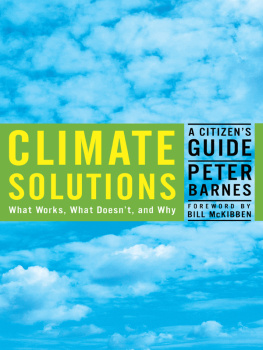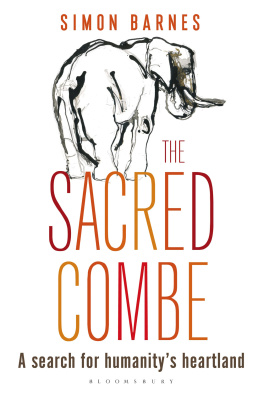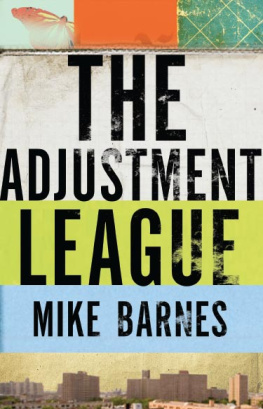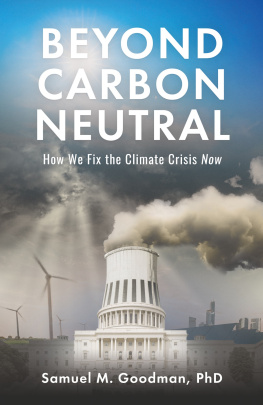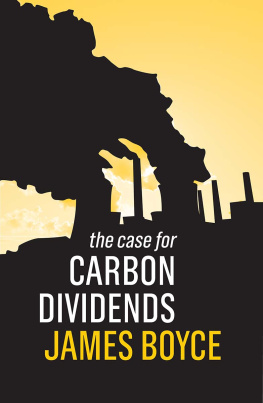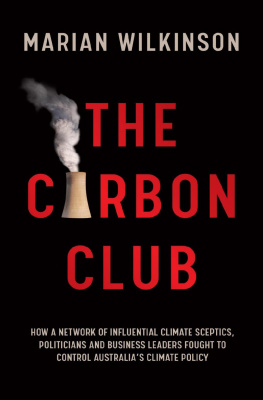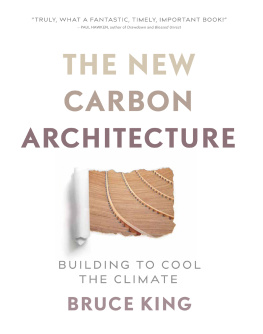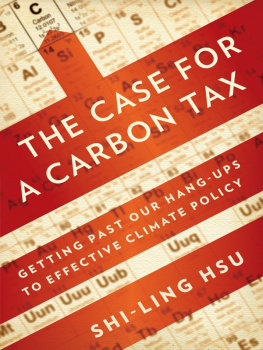
CLIMATE SOLUTIONS
ALSO BY PETER BARNES
Pawns: The Plight of the Citizen-Soldier
Who Owns the Sky?
Capitalism 3.0: A Guide to Reclaiming the Commons
CLIMATE SOLUTIONS
A CITIZENS GUIDE
Peter Barnes
FOREWORD BY BILL MCKIBBEN
CHELSEA GREEN PUBLISHING
WHITE RIVER JUNCTION, VERMONT
2008 by Peter Barnes. All commercial rights reserved. Short quotations may be cited without permission but with attribution. Longer quotations require written permission from the publisher.
An electronic downloadable version is available free of charge at http://www.onthecommons.org and may be distributed for noncommercial purposes without permission, provided the work is attributed to the author and no derivative works are made from it. This electronic version is licensed under the Creative Commons Attribution-NonCommercial-NoDerivs 3.0 License (some restrictions apply). To view a copy of this license, visit http://creativecommons.org/licenses/by-nc-nd/3.0./.
Book design by Peter Holm
Printed in Canada on recycled paper.
First printing, January 2008
10 9 8 7 6 5 4 3 2 1 08 09 10 11
Our Commitment to Green Publishing
Chelsea Green sees publishing as a tool for cultural change and ecological stewardship. We strive to align our book manufacturing practices with our editorial mission and to reduce the impact of our business enterprise in the environment. We print our books and catalogs on chlorine-free recycled paper, using soy-based inks whenever possible. This book may cost slightly more because we use recycled paper, and we hope youll agree that its worth it. Chelsea Green is a member of the Green Press Initiative (www.greenpressinitiative.org), a nonprofit coalition of publishers, manufacturers, and authors working to protect the worlds endangered forests and conserve natural resources. Climate Solutions was printed on 60-lb. Legacy Offset, an FSC-certified 100-percent postconsumer-waste old-growth-forest-free recycled paper supplied by Webcom.
Library of Congress Cataloging-in-Publication Data
Barnes, Peter.
Climate solutions : a citizens guide /
Peter Barnes ; foreword by Bill McKibben.
p. cm.
eBook ISBN: 978-1-60358-073-1
1. Climatic changesGovernment policy.
2. Global environmental changeGovernment policy.
3. Global warmingGovernment policy. I. Title.
QC981.8.C5B365 2008
363.73874--dc22
2007041584
Chelsea Green Publishing Company
Post Ooffice Box 428
White River Junction, VT 05001
(802) 295-6300
www.chelseagreen.com
This book is dedicated to
fellow owners of our one sky.
CONTENTS
| Bill McKibben
FOREWORD
BY BILL MCKIBBEN
In 1992, the first President Bush signed the U.N. Convention on Climate Change, committing the United States to reduce its greenhouse gas emissions to 1990 levels by 2000. Soon after, the U.S. Senate unanimously ratified the Convention.
Since then, our nation has done virtually nothing to meet this commitment. As you read this, our rate of carbon dioxide emissions continues to climb relentlessly.
What will it take for the U.S. to reduce its greenhouse gas emissions rather than increase them? What will it take for us to do this year after year until the Earths climate stabilizes? That very practical question is what this guide is about.
If youve picked up this guide, you dont need to be told that we face a planetary crisis. Youve heard the warnings. You know theres no time to lose. You also know that, although a single citizen cant stop global warming, an army of citizens can.
Fortunately, millions of Americans are now demanding that all levels of governmentlocal, state and federaltake immediate and effective action to cut greenhouse gas emissions. Whats more, many thousands are involved in an extraordinary bottom-up policy development process. Theyre exploring climate solutions and pushing politicians to act. As a result, more than 30 states and 600 cities have adopted policies aimed at cutting carbon emissions. This groundswell has made it a near-certainty that the next President and Congressthe ones who take office in 2009will finally address the climate crisis at the national level.
Hundreds of proposals are floating about, and many of them arent very good.
But theres a big problem. Despite countless conferences and think tank reports, theres no consensus on what solutions will actually work. Hundreds of proposals are floating about, and many of them arent very good. Its quite possible that bad climate policies will be adopted, and that more years will then be lost before real emission reductions occur.
We cant let that happen. Thats why you need to read and circulate this citizens guide. It explains in clear and simple language what different climate policies will doand, just as importantly, what they wont do. It tells you whos behind the policies, whod pay for them, and whod benefit. It demystifies climate policy so that you can play an active role in forming it.
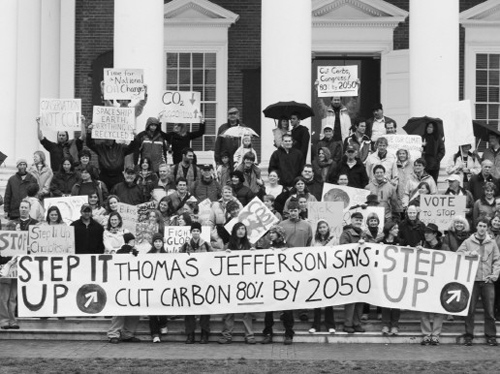
Hundreds of simultaneous rallies have been held across the U.S. as part of the StepIt Up campaign to demand government action on global warming. Above, a rally inCharlottesville, Virginia, as part of the first Step It Up National Day of Climate Actionon April 14, 2007. Photo by Rose Jenkins. Below, a rally in Centerville, Ohio, as part ofthe second Step It Up National Day of Climate Action on November 3, 2007. Photo byScott Knupp.
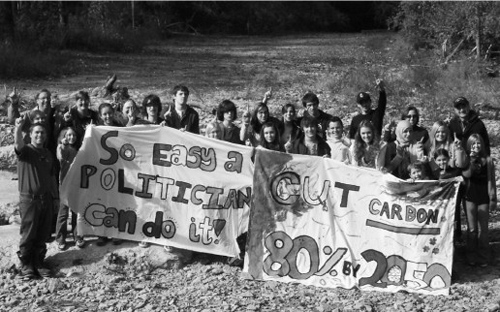
Its time to choose solutions
In a very real sense, this guide ushers in the next stage of the climate debate. In the first stage, we discussed the problem. In the next stage, we must choose solutions.Should we adopt a carbon tax? A carbon cap? A trading system that allows companies to offset their emissions by paying others to plant trees?
We cant wait any longer, and we cant get it wrong.
These are complex questions, but we must come to grips with them. So read this guide and get involved. Join the citizens army that must solve the climate crisis. We cant wait any longer, and we cant get it wrong.
In 2006, NASAs top climate scientist warned that we have at most a decade to turn the tide on global warming. After that, James Hansen said, all bets are off. Temperature rises of 3 to 7 degrees Farenheit will produce a different planet.
If Hansen is rightand most scientists think he isthen every year lost is a year closer to the precipice. In more positive terms, we have one last chancebut only one chanceto save the planet.
This guide is about that last chance. Its two premises are: (1) the climate crisis must be solved now, and (2) popular understanding is a pre-requisite to getting a solution that actually solves the problem.
We have one last chancebut only one chanceto save the planet.
Whats the problem? For many decades, human emissions of greenhouse gases have exceeded the atmospheres capacity to safely absorb them. We need an economy-wide system to reduce those emissions steadily and surely. If a policy doesnt create such a system, it may be helpful, but it wont be enough.
The atmosphere itself is a commonsa gift of creation to all. It performs many vital planetary functions, including climate maintenance. The trouble is, we humansand especially we Americansare disturbing it with our pollution. Even though we know were doing this, we dont stop. Indeed, we
Next page
